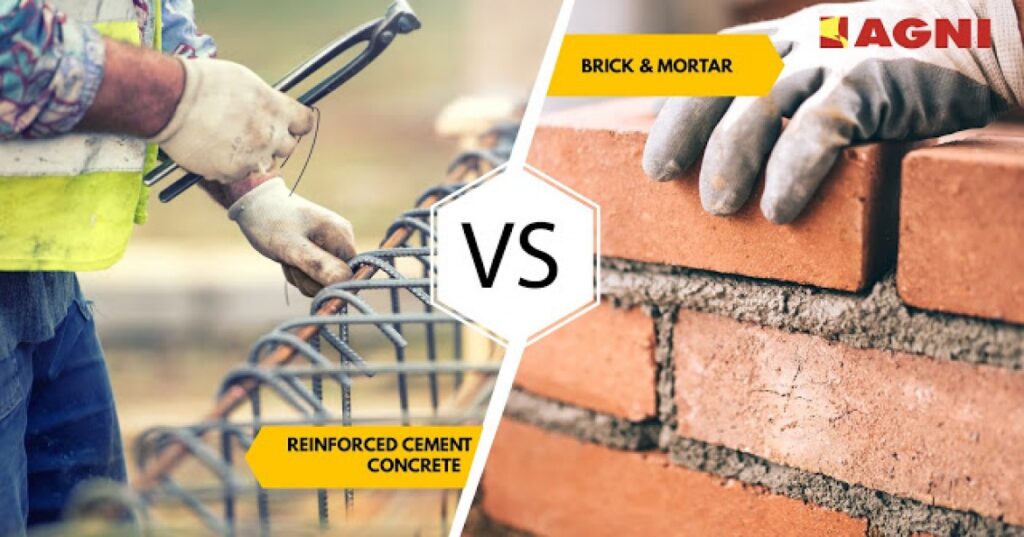In the 21st century, RCC construction (Reinforced Cement Concrete) has become the gold standard in structural engineering, replacing traditional brick-and-mortar buildings for most modern applications. RCC combines the compressive strength of concrete with the tensile strength of TMT steel bars, resulting in unmatched durability and design flexibility.
Unlike brick masonry—which uses bricks joined by a mixture of cement, sand, and water—RCC construction integrates steel reinforcement bars (rebars) within concrete, enhancing the structural performance dramatically.
Here are the key advantages of RCC construction over conventional brick and mortar buildings:
1. Superior Load-Bearing Capacity
RCC structures have a steel-reinforced core, which significantly improves their ability to bear vertical and lateral loads. They withstand the stress of multi-storey construction, heavy equipment, and seismic activity far better than brick structures.
- TMT bars used in RCC improve tensile strength and ductility.
- Brickwork often requires maintenance or repair within 5-10 years, especially under load or moisture exposure.
2. Freedom in Design and Versatility
Since the columns in RCC carry the major loads, walls are no longer structural necessities. This allows for:
- Open floor plans
- Larger rooms, halls, and auditoriums
- Custom architectural styles and modern layouts
Brick constructions rely on load-bearing walls, which limit interior space and flexibility.
3. Shallower Foundations Required
RCC construction demands less excavation because the TMT bars can be strategically placed and grouted into concrete, which bonds exceptionally well.
- Brick foundations often require deeper digging to ensure stability.
- Lower brick layers can degrade, weakening the foundation over time.
4. Long-Term Cost Efficiency
While brickwork may appear cheaper for ground or two-floor structures, RCC construction becomes economical as height increases.
- Lower maintenance costs
- Better lifespan and safety
- Reduced reconstruction or reinforcement needs
5. Disaster Resistance
RCC structures provide better resistance against:
- Earthquakes
- Fire
- Heavy winds
- Floods and other natural calamities
Steel-reinforced buildings distribute shock and maintain integrity, unlike brittle brick constructions.
6. Corrosion Resistance
Modern RCC makes use of corrosion resistant TMT Bars, which improve the life of structures in coastal and high-moisture regions. This gives RCC an edge over brick masonry, which deteriorates quickly in such environments.
7. Suitability for High-Rise and Infrastructure Projects
From skyscrapers and malls to bridges and flyovers, RCC is the backbone of India’s rapid urban development. Brick and mortar buildings cannot support vertical expansion or industrial-scale infrastructure.
8. Sustainability and Energy Efficiency
RCC buildings are more compatible with:
- Precast and modular construction methods
- Energy-efficient designs
- Green building certification.
Materials like TMT bars can be recycled, making RCC a more eco-conscious choice than traditional masonry.
RCC Is the Future of Construction
As India’s urbanisation accelerates, RCC has emerged as the reliable, cost-efficient, and scalable solution for modern buildings. It minimises material waste, improves longevity, and reduces risks, making it a smart investment for both residential and commercial projects.
Powered by Agni Steels
Agni Steels proudly contributes to the future of RCC construction in India with our premium Fe 550D TMT bars and CRS rebars. Our steel products are manufactured with strict quality control, ensuring:
- Superior bonding with concrete
- High strength and flexibility
- Earthquake and corrosion resistance
With a legacy of trust across South India, Agni Steels continues to strengthen the backbone of construction—one bar at a time.


